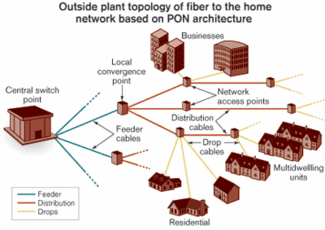AIT Workshop on April 11, 2008 (comments and conclusions) – PART2
One thing I like in life is Mathematics. And the best thing in Mathematics is numbers! In this Workshop much too many figures were provided from either academic modeling or corporate planning. Below are the major findings the way I jotted them down. Comments follow at the end of the post.
1. Dr. Ioannis Tomkos & his team have constructed a business case for Athens Metropolitan Area. The key findings were:
- Total Network Length Required: 5000 Km
- Cost / home passed: 1200 – 1800 euros
- ROI if engaged in retail services: 10 – 12 years
- ROI if engaged in wholesale services: 20- 25 years
- GPON is the most effective architecture for green-field deployments
2. Dr. Philippe Chanlou, France Telecom, Technical Manager, SARDANA presented some information about the France Telecom – Orange FTTH deployment plans.
- They are currently limited to DSL technology; however, this is a high OPEX, low CAPEX solution. They decided to go with GPON for their FTTH deployment
- They estimate that the CAPEX to connect a single customer is approx. 2000 euros
3. Dr. Wolfgang Fischer, Mgr. Business Development Service Provider Infrastructure, Cisco gave some additional small hints (his presentation was focused on the benefits of the Cisco prolonged solution of Active Ethernet (AE) – Point-to-point Ethernet over GPON)
- The lifetime of a fiber project must not be considered to be less than 40 years.
- The bit-rate requirements are increasing with a yearly rate of 50% (Nielsen’s law)
- Key disadvantage in operational terms for GPON is the need to differentiate the customer on the logical level.
- The key disadvantages for AE is that slightly more duct space is needed and that more POP space is needed for fiber management and active equipment
- The CAPEX gains of PON over AE are estimated from 10% to 30%
4. Mr. Risto Soila, Senior Manager, Lightwave Technology, Tellabs presented their involvement in the big Verizon FiOS project
- GPON minimizes the space and power requirements in CO and the passive Outside Plant (OSP) provides the least maintenance necessary.
5. Dr. Costas Saravanos, Product Manager, Corning Cable Systems
- The current cost structure for deploying fiber is 40% labor costs and 60% fixed costs (materials etc).
6. Dr. Tilemachos Doukoglou, Head of R&D Division, Strategy Department, OTE
- P2P Ethernet CAPEX / household = 1200-2500 euros (NOTE: There are additional hidden costs such as building owners agreement, time spent to get inside the building etc.)
- GPON CAPEX / household = 400 -700 euros (for the same project)
7. Dr. Christos Vasilopoulos, Head of Access Network Planning Division, Technology Department, OTE made a very interesting point
- The Capital Expenditure (CAPEX) for each part of OSP are:
- Feeder cables: 10-16%
- Distribution cables: 32-40%
- Drop cables: 44-58%

(I might need a more comprehensive image!)
8. Dr. Polychronis Tzerefos, Future Products Group Manager, Consumer Commercial, Vodafone provided yet another techno-economic clue!
- The estimated budget for a full scale FTTB + VDSL deployment throughout Greece is 0.7 – 1.5 Bn
9. Giannis Rizopoulos, Journalist, Pathfinder, 4th Session Chair said that
- 82% of the OSP CAPEX breakdown is labor
- No numbers can be presented if actual demographics and labor costs are taken into consideration
10. Ms. Elena Katirdji, Access Network Planning, CYTA
- Total Cost per potential & current customers = 800 Euros (This figure does not include excavation costs)
- Total Cost per current customers = 1400 Euros (This figure does not include excavation costs)
- Active Equipment accounts for 51% of the total project CAPEX
- The total labor cost is analyzed as follows:
- 43% for connecting homes (a lot of time spent inside houses to install the distribution equipment)
- 16% for blowing ducts + microducts
- 12% for blowing Cat 5 inside the building
- 29% for all other works
- P2P Ethernet is estimated to be approx 15% more expensive than PON
Can you make any hard conclusion from this? I can’t! A few things stand-out though:
- In order to address the FTTx business case the assumptions have to be fairly realistic (and available, I might add)
- Labor is generally accepted as a key cost driver
- The few dozens/hundreds of meters close to the customer premises are by far then most expensive part of the network
- PON technology is fairly cheaper than P2P Ethernet
- By considering Vodafone’s FTTB + VDSL estimated project cost (1.5Bn) as a cost proxy for an FTTH deployment, the estimated budget by the Ministry (3Bn) is clearly justifiable.



Good stuff. Let me make a request though, if I may: please, make the extra effort to explain all those acronyms! In our field it is hard to keep them all in the brain’s “cache”
Point taken. Thanx pastith.
[...] Wolfang Fischer, Business Development Manager, CISCO presented the case of point to point Ethernet, its benefits in respect of deployment cost and open access regulation [see previous post]. [...]